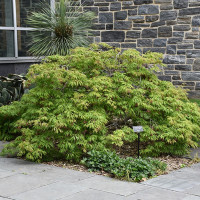European spindle or common spindle / Euonymus europaeus
Deciduous shrub or small tree, up to 2-5 meters high. The branches are obtusely tetrahedral or round, green, with brownish corky ribs, later grayish-brown.
The wood is yellowish, usually whitening in the air, unpleasantly smelling when fresh, light (average specific gravity 0.68), loose. The root bark contains gutta (up to 4%).
The kidneys are small, ovoid-conical. Leaves petiolate (petiole 2-15 mm long), oblong, ovate-elliptic or obovate, rarely broadly ovate, (1.5)3-7(11.5) cm long, widest in the middle and slightly higher, 1-4( 6.5) cm wide, wedge-shaped at the base, evenly serrated at the edges, with hook-shaped teeth, rounded at the apex, except for the lower leaves, with a short pointed tip (shorter than 1⁄10 of the blade), slightly leathery, glabrous above, dull, below only shortly pubescent along the veins.
The inflorescence is a semi-umbel with one underdeveloped middle flower, once or twice splayed forked, 2-5-flowered, shorter or less often longer than the lower reduced covering leaves of the branch, only the lower pair of flowers of the inflorescence comes directly from the scales. Pedicels 2-3.5 cm long. Bracts subulate; the bracts close to them are scaly, often remaining at the base of the pedicels. The flowers are four-dimensional, small, 10-12 mm in diameter, two to three times shorter than the pedicels; calyx with broadly ovate, obtuse lobes, half as long as petals; petals spatulate-prolonged, yellowish-greenish, obtuse, ciliated along the curved edge, serrated; stamens with filaments 1.5-2 mm long, with yellowish anthers; ovary obtuse, naked; style almost cylindrical, shorter than stamens, with obtuse, slightly four-lobed stigma. Blooms in April - June.
The fruit is a four-lobed, drooping capsule 1.5 cm in diameter, broadly pear-shaped from a narrowed base, depressed at the end, 7-13 mm long, with blunt-keeled lobes, smooth, glabrous, first green, then pink-red.
Seeds one by one in the nest, obovate, whitish, entirely dressed with a red-orange roof, together with which they are up to 10 mm long, ripen in June - October.
Winter-hardy. Medium shade tolerant, drought tolerant.
It is used as an ornamental shrub in landscaping, decorative leaf color and bright fruits in autumn. Often planted along fences and hedges.
It has a hard, durable wood that holds metal fasteners well. It lends itself well to turning, polishing. Used on shoe nails, spindles, keys, knitting needles and other small items. Suitable for various types of engraving and carving work. Among the spindle trees, the wood of the European spindle tree is of the greatest importance.
It gives a loose and delicate coal, used in France for the manufacture of gunpowder, but it is especially valued in drawing, as it is erased without a trace, it is used to make ink pencils.
Due to its medium guttivity, it is of particular interest as gutta-perchenos.
Poisonous fruits are used as an emetic and strong laxative, and when crushed in folk medicine, they are used to get rid of external parasites and scabies.
A decoction of seed pods gives an unstable dye with alum of yellow-straw color, and with iron salts - brown. The orange substance of the seed roof is used for coloring morocco leather, as well as in the folk cosmetics of the eastern peoples.

No questions about this product, be the first and ask your question.
























